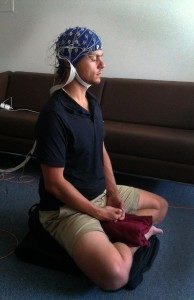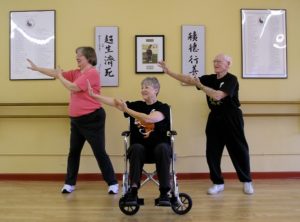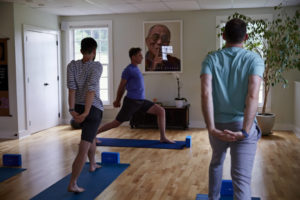Measure Mindfulness Better in Depressed Patients with Changes in the EEG
By John M. de Castro, Ph.D.
“as the popularity of mindfulness grows, brain imaging techniques are revealing that this ancient practice can profoundly change the way different regions of the brain communicate with each other – and therefore how we think – permanently.” – Tom Ireland
Mindfulness training has been shown to improve health and well-being. It has also been found to be effective for a large array of medical and psychiatric conditions, either stand-alone or in combination with more traditional therapies. As a result, mindfulness training has been called the third wave of therapies. One problem with understanding mindfulness effects is that there are, a wide variety of methods of measuring mindfulness. These methods primarily involve self-reports on paper and pencil scales. Unfortunately, these different measures differ conceptually and frequently produce divergent results.
Mindfulness training produces changes in the brain’s electrical activity. This can be measured by recording the electroencephalogram (EEG). The brain produces rhythmic electrical activity that can be recorded from the scalp. It is usually separated into frequency bands. One method to indirectly observe information processing in the brain is to measure the changes in the electrical activity that occur in response to specific stimuli. These are called event-related potentials or ERPs. The signal following a stimulus changes over time. The fluctuations of the signal after specific periods of time are thought to measure different aspects of the nervous system’s processing of the stimulus. Perhaps change in the ERPs resulting from mindfulness training may be a good measure of the increased mindfulness produced by the training and a strong predictor of symptom improvements.
In today’s Research News article “Measuring Mindfulness: A Psychophysiological Approach.” (See summary below or view the full text of the study at: https://www.ncbi.nlm.nih.gov/pmc/articles/PMC6031749/ ), Bostanov and colleagues recruited adult patients with recurrent depression in remission and randomly assigned them to receive 8 weekly, 2 hour group sessions of either Mindfulness-Based Cognitive Therapy (MBCT) or group Cognitive Therapy (CT). They were also assigned 45 minutes of daily homework. MBCT begins with breath meditation and bodily sensation and progresses into learning to perceive thoughts and emotions as objects of mindful attention and as mental events and not as absolute truth, self or reality. CT contained all of the cognitive therapy components as MBCT but excluded mindfulness training.
The participants were measured before and after training for mindfulness, depression, positive and negative emotions, decentering, and curiosity. They also underwent recording from the scalp of electrical brain activity in response to a stimulus (event-related brain potentials, ERPs). With the participants instructed to perform breath meditation, they were periodically presented with a brief noise. The changes in the EEG in response to the noise were recorded and used to calculate the grand average event-related brain potentials.
They found that both the MBCT and CT groups had significant reductions in depression, rumination, and distraction and increases in mindfulness following the 8-week intervention period and one year later. Importantly, they found that the greater the change in the grand average event-related brain potentials resulting from treatment, the greater the reduction in depression symptoms and the greater the increase in mindfulness. These relationships were statistically strong. At the same time changes in the paper and pencil mindfulness measures were not significantly related to the improvements in depression.
These results suggest that changes in the brain are produced by mindfulness training and that these are reflected by changes in the electrical activity of the brain in response to sounds. The results further suggest that these brain activity changes are a better measure of the effectiveness of the mindfulness training than the traditional self-report measures. It was suggested that in the future these event related potential changes be used as the primary assessment instrument for mindfulness and the impact of mindfulness training on the individual.
So, measure mindfulness better in depressed patients with Changes in the EEG.
“Although meditation research is still in its infancy, a number of studies have investigated changes in brain activation at rest and during specific tasks that are associated with the practice of, or that follow, training in mindfulness meditation. There is emerging evidence that mindfulness meditation might cause neuroplastic changes in the structure and function of brain regions involved in regulation of attention, emotion and self-awareness.” – Sarah McKay
CMCS – Center for Mindfulness and Contemplative Studies
This and other Contemplative Studies posts are also available on Google+ https://plus.google.com/106784388191201299496/posts and on Twitter @MindfulResearch
Study Summary
Bostanov, V., Ohlrogge, L., Britz, R., Hautzinger, M., & Kotchoubey, B. (2018). Measuring Mindfulness: A Psychophysiological Approach. Frontiers in Human Neuroscience, 12, 249. http://doi.org/10.3389/fnhum.2018.00249
Abstract
Mindfulness-based interventions have proved effective in reducing various clinical symptoms and in improving general mental health and well-being. The investigation of the mechanisms of therapeutic change needs methods for assessment of mindfulness. Existing self-report measures have, however, been strongly criticized on various grounds, including distortion of the original concept, response bias, and other. We propose a psychophysiological method for the assessment of the mindfulness learned through time-limited mindfulness-based therapy by people who undergo meditation training for the first time. We use the individual pre-post-therapy changes (dERPi) in the event-related brain potentials (ERPs) recorded in a passive meditation task as a measure of increased mindfulness. dERPi is computed through multivariate assessment of individual participant’s ERPs. We tested the proposed method in a group of about 70 recurrently depressed participants, randomly assigned in 1.7:1 ratio to mindfulness-based cognitive therapy (MBCT) or cognitive therapy (CT). The therapy outcome was measured by the long-term change (dDS) relative to baseline in the depression symptoms (DS) assessed weekly, for 60 weeks, by an online self-report questionnaire. We found a strong, highly significant, negative correlation (r = −0.55) between dERPi (mean = 0.4) and dDS (mean = −0.7) in the MBCT group. Compared to this result, the relationship between dDS and the other (self-report) measures of mindfulness we used was substantially weaker and not significant. So was also the relationship between dERPi and dDS in the CT group. The interpretation of dERPi as a measure of increased mindfulness was further supported by positive correlations between dERPi and the other measures of mindfulness. In this study, we also replicated a previous result, namely, the increase (dLCNV) of the late contingent negative variation (LCNV) of the ERP in the MBCT group, but not in the control group (in this case, CT). We interpreted dLCNV as a measure of increased meditative concentration. The relationship between dLCNV and dDS was, however, very week, which suggests that concentration might be relatively unimportant for the therapeutic effect of mindfulness. The proposed psychophysiological method could become an important component of a “mindfulness test battery” together with self-report questionnaires and other newly developed instruments.
https://www.ncbi.nlm.nih.gov/pmc/articles/PMC6031749/









